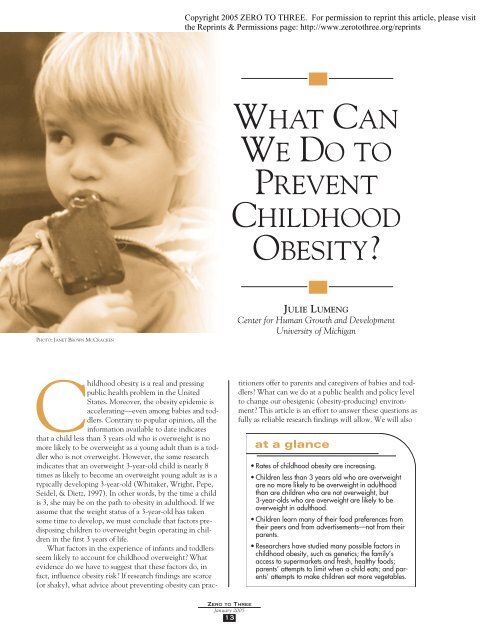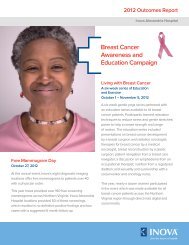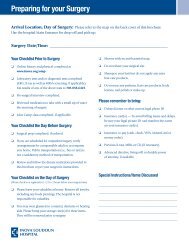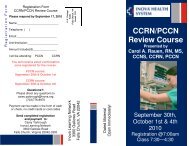what can we do to prevent childhood obesity? - Zero to Three
what can we do to prevent childhood obesity? - Zero to Three
what can we do to prevent childhood obesity? - Zero to Three
You also want an ePaper? Increase the reach of your titles
YUMPU automatically turns print PDFs into web optimized ePapers that Google loves.
WHAT CAN<br />
WE DO TO<br />
PREVENT<br />
CHILDHOOD<br />
OBESITY?<br />
PHOTO:JANET BROWN MCCRACKEN<br />
JULIE LUMENG<br />
Center for Human Growth and Development<br />
University of Michigan<br />
Childhood <strong>obesity</strong> is a real and pressing<br />
public health problem in the United<br />
States. Moreover, the <strong>obesity</strong> epidemic is<br />
accelerating—even among babies and <strong>to</strong>ddlers.<br />
Contrary <strong>to</strong> popular opinion, all the<br />
information available <strong>to</strong> date indicates<br />
that a child less than 3 years old who is over<strong>we</strong>ight is no<br />
more likely <strong>to</strong> be over<strong>we</strong>ight as a young adult than is a <strong>to</strong>ddler<br />
who is not over<strong>we</strong>ight. Ho<strong>we</strong>ver, the same research<br />
indicates that an over<strong>we</strong>ight 3-year-old child is nearly 8<br />
times as likely <strong>to</strong> become an over<strong>we</strong>ight young adult as is a<br />
typically developing 3-year-old (Whitaker, Wright, Pepe,<br />
Seidel, & Dietz, 1997). In other words, by the time a child<br />
is 3, she may be on the path <strong>to</strong> <strong>obesity</strong> in adulthood. If <strong>we</strong><br />
assume that the <strong>we</strong>ight status of a 3-year-old has taken<br />
some time <strong>to</strong> develop, <strong>we</strong> must conclude that fac<strong>to</strong>rs predisposing<br />
children <strong>to</strong> over<strong>we</strong>ight begin operating in children<br />
in the first 3 years of life.<br />
What fac<strong>to</strong>rs in the experience of infants and <strong>to</strong>ddlers<br />
seem likely <strong>to</strong> account for <strong>childhood</strong> over<strong>we</strong>ight? What<br />
evidence <strong>do</strong> <strong>we</strong> have <strong>to</strong> suggest that these fac<strong>to</strong>rs <strong>do</strong>, in<br />
fact, influence <strong>obesity</strong> risk? If research findings are scarce<br />
(or shaky), <strong>what</strong> advice about <strong>prevent</strong>ing <strong>obesity</strong> <strong>can</strong> prac-<br />
titioners offer <strong>to</strong> parents and caregivers of babies and <strong>to</strong>ddlers?<br />
What <strong>can</strong> <strong>we</strong> <strong>do</strong> at a public health and policy level<br />
<strong>to</strong> change our obesigenic (<strong>obesity</strong>-producing) environment?<br />
This article is an effort <strong>to</strong> ans<strong>we</strong>r these questions as<br />
fully as reliable research findings will allow. We will also<br />
at a glance<br />
• Rates of <strong>childhood</strong> <strong>obesity</strong> are increasing.<br />
• Children less than 3 years old who are over<strong>we</strong>ight<br />
are no more likely <strong>to</strong> be over<strong>we</strong>ight in adulthood<br />
than are children who are not over<strong>we</strong>ight, but<br />
3-year-olds who are over<strong>we</strong>ight are likely <strong>to</strong> be<br />
over<strong>we</strong>ight in adulthood.<br />
• Children learn many of their food preferences from<br />
their peers and from advertisements—not from their<br />
parents.<br />
• Researchers have studied many possible fac<strong>to</strong>rs in<br />
<strong>childhood</strong> <strong>obesity</strong>, such as genetics; the family’s<br />
access <strong>to</strong> supermarkets and fresh, healthy foods;<br />
parents’ attempts <strong>to</strong> limit when a child eats; and parents’<br />
attempts <strong>to</strong> make children eat more vegetables.<br />
ZERO TO THREE<br />
January 2005<br />
13
define some terms that are used in medical discussions<br />
about <strong>childhood</strong> <strong>obesity</strong>; attempt <strong>to</strong> dispel some common<br />
misunderstandings about the causes of <strong>childhood</strong> <strong>obesity</strong>;<br />
and suggest some promising approaches for practice,<br />
research, and policy.<br />
Definitions and Data<br />
What is <strong>obesity</strong> in early <strong>childhood</strong>? Obesity is a term for<br />
excessive body fat. We measure<br />
body fat in anyone older than 24<br />
months by calculating body mass<br />
index (BMI; <strong>we</strong>ight in kilograms<br />
divided by the square of height in<br />
meters). Clinicians <strong>can</strong> plot a<br />
child’s BMI on gender-specific<br />
charts provided by the National<br />
Center for Health Statistics (NCHS) of the Centers for<br />
Disease Control (CDC) (http://www.cdc.gov/growthcharts/).<br />
There are no BMI-for-age references or consistent definitions<br />
for over<strong>we</strong>ight for children younger than 2 years.<br />
Ho<strong>we</strong>ver, nutrition programs such as the Special Supplemental<br />
Nutrition Program for Women, Infants and Children<br />
have used <strong>we</strong>ight-for-length recommendations <strong>to</strong><br />
determine over<strong>we</strong>ight and thus program eligibility. Consequently,<br />
over<strong>we</strong>ight in this age group is defined as at or<br />
above the 95th percentile of <strong>we</strong>ight for length (Ogden,<br />
Flegal, Carroll, & Johnson, 2002). Thus, for the remainder<br />
of this discussion, <strong>we</strong> will use the term “over<strong>we</strong>ight” <strong>to</strong><br />
describe children aged 2 years <strong>to</strong> 18 years whose BMI falls<br />
at the 95th percentile or above.<br />
Why <strong>do</strong>es BMI mean something different for adults<br />
than for children? Adults have s<strong>to</strong>pped growing. Because<br />
an adult’s height remains the same, one <strong>can</strong> look at the<br />
<strong>we</strong>ight and height of an adult and calculate BMI in a<br />
straightforward fashion. But think about children. Who<br />
appears <strong>to</strong> be naturally “chubbier”—a healthy 3-year-old<br />
or a 5-year-old? The 3-year-old—because she is still losing<br />
her “baby fat.” All children are naturally at their<br />
“skinniest” when they are bet<strong>we</strong>en 4 and 6 years old.<br />
Then their BMI slowly increases. Compare a 10-year-old<br />
girl about <strong>to</strong> enter puberty <strong>to</strong> a 5-year old girl. The 10<br />
year-old’s BMI is higher, but that is as it should be, given<br />
her stage of development. In other words, different<br />
degrees of “adiposity” (fatness) are normal at different<br />
ages during <strong>childhood</strong>. Babies should be “fat”—but fat<br />
within the normal range on the NCHS <strong>we</strong>ight-for-length<br />
charts. The 3-year-olds who are in the <strong>to</strong>p 5% of the<br />
<strong>we</strong>ight-for-length bell curve are much more likely <strong>to</strong> continue<br />
<strong>to</strong> be over<strong>we</strong>ight in<strong>to</strong> adulthood. And adults who<br />
are at the <strong>to</strong>p end of the BMI bell curve are at increased<br />
risk for serious health problems.<br />
Terminology aside, more of America’s children are<br />
becoming over<strong>we</strong>ight, and <strong>to</strong>day’s over<strong>we</strong>ight children<br />
tend <strong>to</strong> be heavier than over<strong>we</strong>ight children <strong>we</strong>re in past<br />
years. These data are concerning for a number of reasons.<br />
An over<strong>we</strong>ight 3-year-old child is<br />
nearly 8 times as likely <strong>to</strong> become<br />
an over<strong>we</strong>ight young adult as is a<br />
typically developing 3-year-old.<br />
First of all, the <strong>obesity</strong> epidemic is accelerating—even<br />
among our youngest children. For example, bet<strong>we</strong>en 1976<br />
and 2000, the prevalence of over<strong>we</strong>ight in 6- <strong>to</strong> 23-<br />
month-old children increased from 7% <strong>to</strong> nearly 12%.<br />
Most of this increase occurred from 1990 <strong>to</strong> 2000. Among<br />
2- <strong>to</strong> 5-year-old children, the prevalence of over<strong>we</strong>ight<br />
more than <strong>do</strong>ubled (from 5% <strong>to</strong> more than 10%), again<br />
with most of the increase bet<strong>we</strong>en 1990 and 2000 (Ogden<br />
et al., 2002).<br />
Even among very young children,<br />
<strong>we</strong> are seeing signifi<strong>can</strong>t—<br />
and growing—racial disparities in<br />
the prevalence of over<strong>we</strong>ight.<br />
The greatest increases in the<br />
prevalence of over<strong>we</strong>ight bet<strong>we</strong>en<br />
1971 and 1994 occurred in children<br />
of black and Hispanic race/ethnicity (Ogden et al.,<br />
1997). Racial disparities with respect <strong>to</strong> over<strong>we</strong>ight<br />
appear <strong>to</strong> grow and interact with socioeconomic status as<br />
children grow older. For example, in 1986, the prevalence<br />
of over<strong>we</strong>ight among 12-year-old upper-income White<br />
girls and low-income Afri<strong>can</strong> Ameri<strong>can</strong> and Hispanic<br />
boys of the same age was nearly identical—6.5%. By<br />
1998, the prevalence of over<strong>we</strong>ight in upper-income<br />
White girls was essentially unchanged at 8.7%, but had<br />
more than quadrupled among low-income Afri<strong>can</strong> Ameri<strong>can</strong><br />
and Hispanic boys, at 27.4% (Strauss & Pollack,<br />
2001). Unfortunately, <strong>we</strong> <strong>do</strong> not yet understand the<br />
causes underlying these alarming racial and socioeconomic<br />
disparities in the prevalence of over<strong>we</strong>ight among<br />
children.<br />
Chubby Babies, Fat Adults?<br />
As noted above, all of the information available <strong>to</strong> date<br />
indicates that a child who is over<strong>we</strong>ight at less than 3 years<br />
of age is no more likely <strong>to</strong> be over<strong>we</strong>ight as a young adult<br />
than is a child who is not over<strong>we</strong>ight. Ho<strong>we</strong>ver, a child<br />
who is over<strong>we</strong>ight at 3 years or older is nearly 8 times as<br />
likely <strong>to</strong> be over<strong>we</strong>ight as a young adult than is a 3-yearold<br />
who is not over<strong>we</strong>ight (Whitaker et al., 1997). Why<br />
and how is over<strong>we</strong>ight in early <strong>childhood</strong> tied <strong>to</strong> adult <strong>obesity</strong>?<br />
Not surprisingly, current hypotheses focus on genes<br />
and the environment.<br />
Genetic fac<strong>to</strong>rs that predispose <strong>to</strong> <strong>obesity</strong> in a family<br />
may already be expressing themselves in early <strong>childhood</strong>.<br />
Genetic fac<strong>to</strong>rs related <strong>to</strong> <strong>obesity</strong> may include: metabolism<br />
rates, behavioral predispositions <strong>to</strong> food preferences, eating<br />
behavior, and patterns of physical activity. Even among<br />
children younger than 3 years, a child with one parent who<br />
is obese is 3 times as likely <strong>to</strong> become an obese adult as is a<br />
child with two parents of normal <strong>we</strong>ight. A child with two<br />
obese parents is more than 13 times as likely <strong>to</strong> become an<br />
obese adult as is a child with parents of normal <strong>we</strong>ight<br />
(Whitaker et al., 1997). This phenomenon un<strong>do</strong>ubtedly<br />
reflects a complex interplay of biology and behavior. In<br />
ZERO TO THREE<br />
January 2005<br />
14
other words, as <strong>we</strong> have come <strong>to</strong> recognize that with<br />
respect <strong>to</strong> most aspects of child development, the old<br />
dicho<strong>to</strong>my of nature versus nurture represents an oversimplification<br />
of a complex issue.<br />
We <strong>do</strong> know that the dramatic increase in the prevalence<br />
of over<strong>we</strong>ight in the general population and among<br />
children since 1990 absolutely <strong>can</strong>not be accounted for by<br />
genetic shifts in the population. Genetic changes simply <strong>do</strong><br />
not occur this quickly. It is possible,<br />
ho<strong>we</strong>ver, that genetic predispositions<br />
<strong>to</strong>ward certain behaviors<br />
(e.g., preferences for s<strong>we</strong>et or highfat<br />
foods) vary within the population.<br />
When the environment<br />
changes, these genetic predispositions<br />
may be more apt <strong>to</strong> express themselves than formerly;<br />
the result is over<strong>we</strong>ight or <strong>obesity</strong>. The overarching message?<br />
Our genes have not changed recently; our environment<br />
has. What <strong>do</strong>es this conclusion tell us about the<br />
strong transmission of over<strong>we</strong>ight risk from parent <strong>to</strong> child?<br />
Parents’ modeling of behavior and their shaping of a<br />
child’s relationship <strong>to</strong> food have been areas of active<br />
research in child development for quite some time.<br />
Accounts in the lay press <strong>do</strong> not hesitate <strong>to</strong> hold parents<br />
responsible for <strong>childhood</strong> over<strong>we</strong>ight. For example, recent<br />
articles in national newspapers have been headlined, “Over<strong>we</strong>ight<br />
kids? You might deserve a big slice of the<br />
blame”(Lee, 2004), or “If parents <strong>can</strong>’t say no, then their<br />
children won’t learn <strong>to</strong> either” (Hart, 2003). Blaming parents<br />
for a problem that is growing more quickly—and at epidemic<br />
proportions—in disadvantaged minority populations<br />
than in the population as a whole immediately raises concerns<br />
about the validity of this conceptualization of the<br />
problem. If parents are generally and primarily <strong>to</strong> blame for<br />
the increased prevalence of child over<strong>we</strong>ight since 1990,<br />
one or both of the following statements would have <strong>to</strong> be<br />
true: (a) Parenting practices as a whole have shifted dramatically<br />
in the last 15 years, and (b) low-income parents (especially<br />
mothers) have a reasonable chance of overcoming the<br />
influence of both food advertising that is targeted at their<br />
children and the economic conditions in which they live.<br />
Who Influences Children’s Eating<br />
Behavior?<br />
If poor parenting is <strong>to</strong> blame for the growing prevalence<br />
of <strong>childhood</strong> <strong>obesity</strong>, then something must have changed<br />
since 1990 in the ways in which parents teach their children<br />
about food, set limits around food, and promote<br />
healthy eating habits. This assertion is difficult <strong>to</strong> support,<br />
for a variety of reasons. For example, if parents have a po<strong>we</strong>rful<br />
influence over children’s eating behavior and development<br />
of food preferences, then family members’ food<br />
preferences should be very much alike. In fact, very little<br />
correlation exists bet<strong>we</strong>en parent and child food preferences<br />
(even when the children have grown <strong>to</strong> be adults;<br />
Today’s over<strong>we</strong>ight children tend<br />
<strong>to</strong> be heavier than over<strong>we</strong>ight<br />
children <strong>we</strong>re in past years.<br />
Rozin, 1991). Parents are not very effective at transmitting<br />
preferences for foods <strong>to</strong> their children (a finding that will<br />
not surprise any parent or caregiver who has struggled <strong>to</strong><br />
encourage a child <strong>to</strong> sample a new food!).<br />
Although parents have limited control over <strong>what</strong> children<br />
are willing <strong>to</strong> eat while sitting at the dinner table parents<br />
<strong>do</strong> control <strong>what</strong> food is in the cupboards. Given that<br />
<strong>obesity</strong> is more common in low-income minority populations,<br />
perhaps efforts should focus<br />
on encouraging low-income mothers<br />
with young children <strong>to</strong> s<strong>to</strong>ck<br />
the house with a range of healthy<br />
food options for their children.<br />
Unfortunately, this recommendation<br />
is problematic from a public<br />
health perspective. Consider, for example, the research finding<br />
that families who live closer <strong>to</strong> supermarkets are more<br />
likely <strong>to</strong> consume a healthier diet than are families who live<br />
further away, presumably because those living closer have<br />
readier access <strong>to</strong> a range of fresh and healthy foods (Morland,<br />
Wing, & Roux, 2002). Ho<strong>we</strong>ver, the number of supermarkets<br />
per capita is nearly 6 times greater in White<br />
neighborhoods than it is in neighborhoods of primarily<br />
minority race/ethnicity (Morland, Wing, Roux, & Poole,<br />
2002). The reasons for these stark disparities are un<strong>do</strong>ubtedly<br />
complex, and not fully unders<strong>to</strong>od. These differences,<br />
ho<strong>we</strong>ver, would potentially be amenable <strong>to</strong> public policy<br />
intervention.<br />
Where <strong>do</strong> children learn their food preferences? The<br />
bulk of the evidence suggests that even children as young<br />
as 2 years learn food preferences from their peer group. In<br />
one study, researchers in a preschool setting seated children<br />
who didn’t like broccoli next <strong>to</strong> children who did.<br />
The broccoli eaters ate their green vegetable in full view of<br />
their broccoli-averse classmates. Over time, the children<br />
who hadn’t liked broccoli began <strong>to</strong> eat it (Birch, 1980). In<br />
a more recent experiment, teachers in a preschool setting<br />
and peer models <strong>we</strong>re put head-<strong>to</strong>-head <strong>to</strong> determine who<br />
was more likely <strong>to</strong> influence a child’s food preferences. The<br />
children <strong>we</strong>re signifi<strong>can</strong>tly more po<strong>we</strong>rful influences than<br />
the adults <strong>we</strong>re (Hendy & Raudenbush, 2000).<br />
Evolutionary biology suggests two principal reasons why<br />
peers may be more po<strong>we</strong>rful than adults in shaping children’s<br />
food preferences:<br />
• Young children’s reluctance <strong>to</strong> sample new foods is<br />
biologically wired. Reluctance <strong>to</strong> try new foods begins<br />
<strong>to</strong> emerge at around age 2 years and lessens as children<br />
approach school age. The unfamiliar foods that children<br />
are most reluctant <strong>to</strong> try are vegetables (Cooke, Wardle,<br />
& Gibson, 2003). That children become reluctant <strong>to</strong><br />
sample new foods just as they are becoming mobile,<br />
independent explorers seems <strong>to</strong> be more than mere<br />
coincidence. It would be <strong>to</strong> the human species’ survival<br />
advantage for its young <strong>to</strong> be reluctant <strong>to</strong> eat unfamiliar<br />
ZERO TO THREE<br />
January 2005<br />
15
plant life (e.g., vegetables): Plants <strong>can</strong> be poisonous.<br />
Instead of tasting any new item that they encounter,<br />
human children (in fact, nearly all mammals) determine<br />
<strong>what</strong> <strong>to</strong> eat by observing others around them.<br />
• Modeling eating behavior after peers may provide<br />
young children with some survival advantage. A<br />
biological perspective suggests that the nutritional<br />
needs of the young human are more similar <strong>to</strong> those of<br />
other young humans than <strong>to</strong> those of full-grown<br />
adults. For example, because children’s bodies are<br />
smaller than those of adults and <strong>to</strong> some extent less<br />
able <strong>to</strong> protect against infection, foods that adults <strong>can</strong><br />
eat or drink safely in reasonable quantities could prove<br />
<strong>to</strong>xic <strong>to</strong> a young child (e.g., sushi, steak tartar, unpasteurized<br />
apple cider, and alcohol).<br />
In brief, if nature had tried <strong>to</strong> equip children’s brains<br />
with a preset system for recognizing which foods are safe <strong>to</strong><br />
eat, a system that led children <strong>to</strong> imitate the behavior of<br />
the organisms most like themselves (i.e., other children),<br />
would clearly be the best design. This appears <strong>to</strong> be,<br />
indeed, the food-selection system that children use.<br />
Unfortunately, advertisers seem <strong>to</strong> have recognized the<br />
po<strong>we</strong>r of peers <strong>to</strong> influence children’s food preferences long<br />
before the rest of us. Anyone who has ever watched television<br />
recognizes that <strong>to</strong> sell food <strong>to</strong> children, advertisers use<br />
other children (e.g., “Mikey”) or characters designed <strong>to</strong><br />
appeal <strong>to</strong> and resonate with children. No cereal or <strong>can</strong>dy<br />
company would ever attempt <strong>to</strong> sell a product <strong>to</strong> a child<br />
with a commercial featuring a firm (yet kind and gentle)<br />
adult model eating the product while enthusiastically<br />
explaining <strong>to</strong> the child how “yummy” it is. Para<strong>do</strong>xically,<br />
this is exactly the method by which parents try <strong>to</strong> get children<br />
<strong>to</strong> eat healthy foods. Perhaps reframing our efforts at<br />
changing <strong>childhood</strong> eating behavior is in order.<br />
Food advertisements on television are po<strong>we</strong>rful. Children’s<br />
consumption of specific foods correlates with their<br />
having vie<strong>we</strong>d advertisements for these foods. Obese children<br />
are more likely than are children of normal <strong>we</strong>ight <strong>to</strong><br />
recognize food advertisements on television (Halford,<br />
Gillespie, Brown, Pontin, & Dovey, 2004). Even children<br />
as young as 2 years are more likely <strong>to</strong> select a food that<br />
they recently saw advertised in a 30-second commercial<br />
embedded in a car<strong>to</strong>on than are children who have<br />
watched the car<strong>to</strong>on without the commercial (Borzekowski<br />
& Robinson, 2001). Unless the government <strong>can</strong> be convinced<br />
<strong>to</strong> provide sufficient funding <strong>to</strong> advertise vegetables,<br />
whole grains, and milk on television with the same<br />
vigor and enormous advertising budget of the junk-food<br />
industry, hawking healthy food <strong>to</strong> children through television<br />
may be an unreachable goal. Ho<strong>we</strong>ver, children who<br />
attend preschool and child care are exposed <strong>to</strong> peers in eating<br />
situations every day. These interactions may be prime<br />
opportunities for promoting the transmission of healthy<br />
food preferences bet<strong>we</strong>en and among children.<br />
PHOTO:MARILYN NOLT<br />
What Is the Right Way <strong>to</strong> Parent <strong>to</strong><br />
Prevent Obesity?<br />
Parents <strong>do</strong> exert some control over how their children<br />
learn <strong>to</strong> prefer healthy foods and regulate food intake.<br />
Therefore, professionals who work with the parents of<br />
young children should base their recommendations about<br />
nutrition and feeding on solid scientific evidence. Unfortunately,<br />
although professionals frequently give families<br />
advice on these <strong>to</strong>pics, <strong>we</strong> have little data <strong>to</strong> back up our<br />
suggestions.<br />
For example, early <strong>childhood</strong> professionals and clinicians<br />
generally believe that young infants should be fed<br />
“on demand.” (Whether or not parents actually accept and<br />
implement this advice is an unans<strong>we</strong>red question.) But<br />
although feeding an infant on demand may certainly promote<br />
a sense of security and help the infant <strong>to</strong> calm and<br />
self-regulate, <strong>we</strong> have no evidence <strong>to</strong> suggest that feeding a<br />
baby on demand has anything <strong>to</strong> <strong>do</strong> with her eventual ability<br />
<strong>to</strong> regulate appetite. Interestingly, at some point in the<br />
early <strong>childhood</strong> years, ho<strong>we</strong>ver, general professional opinion<br />
and advice seem <strong>to</strong> shift from feeding “on demand” <strong>to</strong><br />
feeding at scheduled snack and mealtimes. We encourage<br />
parents <strong>to</strong> have a child wait until dinner for food, even if<br />
he or she is clearly hungry. The theory is that the child will<br />
then “have a good appetite” and will “eat a good dinner.”<br />
On the other hand, some professionals advise parents <strong>to</strong><br />
allow young children <strong>to</strong> “graze” on healthy foods all day<br />
long. They counsel parents <strong>to</strong> allow their child <strong>to</strong> eat a<br />
snack when they ask for one, with the thought that the<br />
child is learning <strong>to</strong> respond <strong>to</strong> his hunger cues accurately.<br />
ZERO TO THREE<br />
January 2005<br />
16
Feeding children when they say that they are hungry, these<br />
professionals and parents believe, will teach children that<br />
“<strong>we</strong> eat when <strong>we</strong> are hungry,” not that “<strong>we</strong> eat because it is<br />
dinnertime.”<br />
Evidence <strong>to</strong> support either method of regulating food<br />
intake is s<strong>can</strong>ty. Some data suggest that restricting children’s<br />
access <strong>to</strong> palatable foods makes children like and<br />
want these foods even more over time (Birch, Zimmerman,<br />
& Hind, 1980) and promotes<br />
overeating when the restricted<br />
foods are actually available (Fisher<br />
& Birch, 1999). The more that<br />
mothers control how much, <strong>what</strong>,<br />
and when children eat at age 5<br />
years (regardless of the child’s<br />
<strong>we</strong>ight status at that age), the more<br />
likely the child is <strong>to</strong> eat without<br />
being hungry (i.e., <strong>to</strong> be insensitive <strong>to</strong> hunger cues and<br />
therefore apt <strong>to</strong> overeat) by age 9 years (Birch, Fisher, &<br />
Davison, 2003). These data suggest that parents who set<br />
strict limits on their young children’s eating may actually<br />
promote <strong>obesity</strong>. This information might, therefore, prompt<br />
professionals <strong>to</strong> instruct mothers not <strong>to</strong> restrict the amount,<br />
timing, or content of children’s meals. Ho<strong>we</strong>ver, such<br />
advice runs directly counter <strong>to</strong> how much of the general<br />
public views the cause of <strong>to</strong>day’s <strong>childhood</strong> <strong>obesity</strong> epidemic—lax,<br />
inconsistent parenting with little limit-setting.<br />
Similar confusion exists concerning strategies <strong>to</strong> get<br />
children <strong>to</strong> eat more vegetables. Simply encouraging parents<br />
<strong>to</strong> put vegetables on the dinner table each evening<br />
<strong>do</strong>es not result in children’s becoming more familiar with a<br />
food and therefore more likely <strong>to</strong> eat it. Children must<br />
actually taste a vegetable repeatedly before they begin <strong>to</strong><br />
like it (Birch, McPhee, Shoba, Pirok, & Steinberg, 1987).<br />
If simply prompting a child <strong>to</strong> “take one bite” could make a<br />
typical child easily and pleasantly take a bite of a disliked<br />
vegetable, parenting (and <strong>obesity</strong> <strong>prevent</strong>ion) would certainly<br />
be a much simpler endeavor than it is. Unfortunately,<br />
as <strong>we</strong> have seen, children have an inherent<br />
reluctance <strong>to</strong> sample new vegetables, and parental modeling,<br />
as described above, has limited po<strong>we</strong>r <strong>to</strong> overcome this<br />
reluctance. If these methods fail, parents often then resort<br />
<strong>to</strong> rewarding the child for trying one bite of the vegetable.<br />
Most commonly, parents will tell a child that she may not<br />
leave the table, or may not have dessert, or may not have<br />
any more servings of a preferred food until the target vegetable<br />
is sampled. Unfortunately, it seems that these methods<br />
of reward actually result in a decreased preference for<br />
the target vegetable over time—certainly not the desired<br />
outcome (Birch, Marlin, & Rotter, 1984).<br />
Synthesis of the Research <strong>to</strong> Date<br />
Do <strong>we</strong> have evidence that any feeding practices in the<br />
first few years of life influence <strong>obesity</strong> risk? It is relatively<br />
<strong>we</strong>ll-accepted among researchers that breast-feeding<br />
Although parents have limited<br />
control over <strong>what</strong> children are<br />
willing <strong>to</strong> eat . . .parents <strong>do</strong><br />
control <strong>what</strong> food is in the<br />
cupboards.<br />
reduces the risk of <strong>obesity</strong> (Hediger, Overpeck, Kuczmarski,<br />
& Ruan, 2001), although questions remain concerning<br />
whether this correlation is simply due <strong>to</strong> the<br />
presence of confounders, such as the general healthconsciousness<br />
of mothers who breast-feed (Parsons, Po<strong>we</strong>r,<br />
& Manor, 2003). If one accepts that a relationship exists<br />
bet<strong>we</strong>en breast-feeding and lo<strong>we</strong>red risk of <strong>obesity</strong>, one<br />
should note that breast-feeding in infancy has not been<br />
found <strong>to</strong> be associated with protection<br />
against over<strong>we</strong>ight among<br />
children of preschool age in all<br />
populations. Among low-income<br />
children, for example, the relationship<br />
bet<strong>we</strong>en breast-feeding<br />
and protection against over<strong>we</strong>ight<br />
is present only in white children—<br />
not in black or Hispanic children<br />
(Grummer-Strawn & Mei, 2004). The reason for this discrepancy<br />
remains unclear. Researchers are also debating<br />
whether or not the timing of a baby’s introduction <strong>to</strong> solid<br />
foods is associated with an increased risk of child over<strong>we</strong>ight.<br />
Most recent research seems <strong>to</strong> indicate that introduction<br />
of solid foods before 4–6 months <strong>do</strong>es not seem <strong>to</strong><br />
be associated with infant <strong>we</strong>ight status, at least at 12<br />
months of age. We have no data about timing of solid food<br />
introduction and <strong>we</strong>ight status at age 3 years or later. The<br />
use of food as a reward (for example, <strong>to</strong> avert a tantrum)<br />
has been associated with children’s increased preference for<br />
the food that has been used as a reward (Birch et al.,<br />
1980). Ho<strong>we</strong>ver, the children of mothers who report that<br />
they use food as a reward <strong>do</strong> not seem, as a group, <strong>to</strong> be<br />
particularly obese (Baughcum et al., 2001).<br />
Because of the high prevalence of <strong>obesity</strong> among children<br />
living in poverty, several researchers have studied the<br />
feeding practices of low-income mothers of young children.<br />
Ho<strong>we</strong>ver, efforts <strong>to</strong> relate children’s <strong>we</strong>ight status at 11 <strong>to</strong><br />
24 months of age <strong>to</strong> self-reported maternal feeding practices<br />
in low-income populations have not uncovered any<br />
clear associations. Baughcum and her colleagues (2001)<br />
found that low-income mothers of children who <strong>we</strong>re over<strong>we</strong>ight<br />
did not report being more concerned about their<br />
infant’s hunger, being less aware of their infant’s hunger<br />
and satiety cues, feeding their infant more on a schedule,<br />
being more likely <strong>to</strong> use food <strong>to</strong> calm their infant, or having<br />
less social interaction during feeding than did lowincome<br />
mothers of children of normal <strong>we</strong>ight. Ho<strong>we</strong>ver,<br />
low-income obese mothers in this study <strong>we</strong>re more likely <strong>to</strong><br />
be concerned about their baby’s being under<strong>we</strong>ight than<br />
other mothers. Given their concern, obese mothers may<br />
have been more apt <strong>to</strong> overfeed their babies, and thereby<br />
place them at greater risk for over<strong>we</strong>ight. Regardless of the<br />
<strong>we</strong>ight status of child or mother, low-income mothers are<br />
more likely <strong>to</strong> be concerned about their child’s hunger<br />
than are higher-income mothers (Baughcum et al., 2001).<br />
Low-income mothers said that they found it difficult <strong>to</strong><br />
ZERO TO THREE<br />
January 2005<br />
17
withhold food from a child who said he or she was hungry,<br />
even if the child had just finished a meal.<br />
Results from the same authors for children 23 <strong>to</strong> 60<br />
months of age provide equally confusing information for<br />
the practitioner who wants <strong>to</strong> provide straightforward<br />
advice <strong>to</strong> a family. The researchers found that obese mothers<br />
and low-income mothers <strong>we</strong>re more likely <strong>to</strong> engage in<br />
<strong>what</strong> professionals consider age-inappropriate feeding practices<br />
than <strong>we</strong>re non-obese or<br />
upper-income mothers (Baughcum<br />
et al., 2001). For example, lowincome<br />
<strong>to</strong>ddlers and preschoolers<br />
<strong>we</strong>re more likely than upperincome<br />
young children <strong>to</strong> eat in<br />
front of the TV or walking around<br />
the living room rather than having<br />
a meal at a table with a place setting.<br />
Lo<strong>we</strong>r-income mothers said that they had less difficulty<br />
feeding their children than did higher-income<br />
mothers, but low-income mothers reported a tendency <strong>to</strong><br />
push their children <strong>to</strong> eat more. Ho<strong>we</strong>ver, none of these<br />
frowned-upon feeding practices <strong>we</strong>re associated with<br />
increased risk of over<strong>we</strong>ight at age 5 years.<br />
In summary, <strong>we</strong> find no evidence from mothers’ reports<br />
that over<strong>we</strong>ight children experience a different feeding<br />
style from their mothers than <strong>do</strong> non-over<strong>we</strong>ight children.<br />
Although lo<strong>we</strong>r-income mothers <strong>do</strong> feed their young children<br />
differently than <strong>do</strong> upper-income mothers, <strong>we</strong> have<br />
no evidence that these different feeding practices are actually<br />
related <strong>to</strong> an increased risk of child over<strong>we</strong>ight. In<br />
other words, the fact that a low-income mother chooses <strong>to</strong><br />
have unstructured mealtimes, encourages her child <strong>to</strong> eat<br />
more, allows her child <strong>to</strong> have a bottle during the day, or<br />
will feed the child herself if the child <strong>do</strong>es not want <strong>to</strong> eat,<br />
may reflect sociocultural differences bet<strong>we</strong>en lo<strong>we</strong>r-income<br />
and upper-income parents in their beliefs about feeding<br />
practices. Professionals have no basis on which <strong>to</strong> make a<br />
value judgment about these practices as they pertain <strong>to</strong><br />
child over<strong>we</strong>ight outcomes.<br />
Some data suggest that<br />
restricting children’s access <strong>to</strong><br />
palatable foods makes children<br />
like and want these foods even<br />
more over time.<br />
What Should Professionals Recommend<br />
<strong>to</strong> Parents?<br />
We have revie<strong>we</strong>d the research on young children’s<br />
eating behavior and parental feeding practices (with a particular<br />
focus on low-income minority children) and their<br />
relationship <strong>to</strong> <strong>childhood</strong> over<strong>we</strong>ight. We have found an<br />
absence of robust research <strong>to</strong> guide us in advising parents<br />
about how <strong>to</strong> <strong>prevent</strong> <strong>childhood</strong> over<strong>we</strong>ight. What advice<br />
should professionals give <strong>to</strong> parents of young children about<br />
feeding practices? Research suggests four guidelines for<br />
practice:<br />
1. Acknowledge the limits of parental influence in the<br />
face of an obesigenic environment.<br />
Especially when working with disadvantaged parents,<br />
acknowledge that although parents influence their children’s<br />
eating and will <strong>do</strong> the best job they <strong>can</strong> <strong>to</strong> <strong>prevent</strong><br />
<strong>obesity</strong> in their child, individual parents are constantly<br />
battling a myriad of societal and biological influences on<br />
their child’s eating behavior.<br />
2. Empo<strong>we</strong>r parents <strong>to</strong> advocate for systemic change.<br />
Parents are in a prime position <strong>to</strong> advocate for change<br />
in their children’s child-care and preschool settings with<br />
regard <strong>to</strong> the foods served and the mealtime atmosphere.<br />
Parents are also important voices<br />
in advocating for more and safer<br />
playgrounds in their neighborhoods<br />
so that children <strong>can</strong> get<br />
exercise out<strong>do</strong>ors.<br />
3. Refrain from urging parents<br />
<strong>to</strong> change their feeding practices<br />
when <strong>we</strong> have little<br />
scientific evidence <strong>to</strong> suggest that<br />
these are actually “wrong.”<br />
Although allowing a child <strong>to</strong> walk around all day with<br />
a bottle of juice is certainly problematic from an oral<br />
health perspective, professionals tend <strong>to</strong> frown on other<br />
feeding practices without compelling evidence that these<br />
practices increase children’s risk of poor health outcomes.<br />
For example, telling a mother <strong>to</strong> have structured mealtimes<br />
rather than allowing her young child <strong>to</strong> “graze” has little<br />
basis in science, and may only serve <strong>to</strong> alienate a mother<br />
from the health care provider. She is likely <strong>to</strong> be feeding<br />
her child as her mother fed her, and as her cultural and<br />
socioeconomic peers feed their children.<br />
4. Advocate, advocate, advocate.<br />
Although working with individual families <strong>to</strong> reduce<br />
their child’s risk for over<strong>we</strong>ight is important, advocating<br />
for change on a public health and policy level is critical.<br />
Providing low-income families in both urban and rural<br />
areas with ready access <strong>to</strong> fresh and palatable fruits and<br />
vegetables would be an important change for the better.<br />
Increasing the availability of healthy, tasty, and inexpensive<br />
fast food could also make a big difference in children’s<br />
health. Although an upper-income working family <strong>can</strong> find<br />
palatable (albeit expensive) rather healthy take-out food in<br />
some communities, cost and availability preclude this<br />
option for most low-income families. Yet few low-income<br />
mothers have the time or energy after a long day at work <strong>to</strong><br />
take public transportation (which <strong>do</strong>esn’t exist in many<br />
communities) with several children in <strong>to</strong>w <strong>to</strong> buy fresh<br />
food at a supermarket (which may not exist in the vicinity<br />
of many low-income families’ homes), and then cook while<br />
the children vie for her attention. Because many lowincome<br />
families <strong>do</strong> not feel safe allowing their children <strong>to</strong><br />
play outside in their home neighborhoods, it is important<br />
<strong>to</strong> ensure that, along with healthy meals and snacks, children<br />
get adequate opportunity for physical activity in<br />
child-care, preschool, school, and after-school programs.<br />
Of course our long-term goal should be safe child- andfamily-friendly<br />
communities with ample sources of afford-<br />
ZERO TO THREE<br />
January 2005<br />
18
able, healthy food <strong>to</strong> purchase and accessible resources for<br />
information and physical exercise (including community<br />
gardening).<br />
In Conclusion<br />
The early <strong>childhood</strong> professional <strong>can</strong> play a critical<br />
role in stemming the tide of <strong>childhood</strong> over<strong>we</strong>ight. Ho<strong>we</strong>ver,<br />
this role may not play out in the home of the individual<br />
family as much as it may in the Early Head Start or<br />
Head Start classroom or the community meeting hall. Preventing<br />
<strong>childhood</strong> over<strong>we</strong>ight will, as the saying goes,<br />
take a village. A<br />
REFERENCES<br />
Baughcum, A., Po<strong>we</strong>rs, S., Johnson, S., Chamberlin, L., Deeks, C., Jain,<br />
A., et al. (2001). Maternal feeding practices and beliefs and their relationships<br />
<strong>to</strong> over<strong>we</strong>ight in early <strong>childhood</strong>. Journal of Developmental &<br />
Behavioral Pediatrics, 22(6), 391–408.<br />
Birch, L. (1980). Effects of peer models’ food choices and eating behaviors<br />
on preschoolers’ food preferences. Child Development, 51, 489–496.<br />
Birch, L., Fisher, J., & Davison, K. (2003). Learning <strong>to</strong> overeat: Maternal<br />
use of restrictive feeding practices promotes girls’ eating in the absence<br />
of hunger. Ameri<strong>can</strong> Journal of Clinical Nutrition, 78(2), 215–220.<br />
Birch, L., Marlin, D., & Rotter, J. (1984). Eating as the “means” activity<br />
in a contingency: Effects on young children’s food preference. Child<br />
Development, 55, 432–439.<br />
Birch, L., McPhee, L., Shoba, B., Pirok, E., & Steinberg, L. (1987). What<br />
kind of exposure reduces children’s food neophobia? Appetite, 3,<br />
353–360.<br />
Birch, L., Zimmerman, S., & Hind, H. (1980). The influence of socialaffective<br />
context on the formation of children’s food preferences. Child<br />
Development, 51(3), 856–861.<br />
Borzekowski, D., & Robinson, T. (2001). The 30-second effect: An<br />
experiment revealing the impact of television commercials on food<br />
preferences of preschoolers. Journal of the Ameri<strong>can</strong> Dietetic Association,<br />
101(1), 42–46.<br />
Cooke, L., Wardle, J., & Gibson, E. (2003). Relationship bet<strong>we</strong>en<br />
parental report of food neophobia and everyday food consumption in<br />
2–6-year-old children. Appetite, 41(2), 205–206.<br />
Fisher, J., & Birch, L. (1999). Restricting access <strong>to</strong> palatable foods affects<br />
children’s behavioral response, food selection, and intake. Ameri<strong>can</strong><br />
Journal of Clinical Nutrition, 69, 1264–1272.<br />
Grummer-Strawn, L., & Mei, Z. (2004). Does breastfeeding protect<br />
against pediatric over<strong>we</strong>ight? Analysis of longitudinal data from the<br />
Centers for Disease Control and Prevention Nutrition Surveillance<br />
System. Pediatrics, 113(2), e81–e86.<br />
Halford, J., Gillespie, J., Brown, V., Pontin, E., & Dovey, T. (2004).<br />
Effect of television advertisements for foods on consumption in children.<br />
Appetite, 42(2), 221–225.<br />
Hart, B. (2003, November 16). If parents <strong>can</strong>’t say no, then their children<br />
won’t learn <strong>to</strong> either. Chicago Sun-Times, p. 36.<br />
Hediger, M., Overpeck, M., Kuczmarski, R., & Ruan, W. (2001).<br />
Association bet<strong>we</strong>en infant breastfeeding and over<strong>we</strong>ight in young<br />
children. Journal of the Ameri<strong>can</strong> Medical Association, 285, 2453–2460.<br />
Hendy, H., & Raudenbush, B. (2000). Effectiveness of teacher modeling<br />
<strong>to</strong> encourage food acceptance in preschool children. Appetite, 34,<br />
61–76.<br />
Lee, E. (2004, May 30). Over<strong>we</strong>ight kids? You might deserve a big slice<br />
of the blame. Atlanta Journal-Constitution, p. 1A.<br />
Morland, K., Wing, S., & Roux, A. D. (2002). The contextual effect of<br />
the local food environment on residents’ diets: The atherosclerosis risk<br />
in communities study. Ameri<strong>can</strong> Journal of Public Health, 92(11),<br />
1761–1768.<br />
Morland, K., Wing, S., Roux, A. D., & Poole, C. (2002). Neighborhood<br />
characteristics associated with the location of food s<strong>to</strong>res and food service<br />
places. Ameri<strong>can</strong> Journal of Preventive Medicine, 22, 23–29.<br />
Ogden, C., Flegal, K., Carroll, M., & Johnson, C. (2002). Prevalence and<br />
trends in over<strong>we</strong>ight among US children and a<strong>do</strong>lescents, 1999–2000.<br />
Journal of the Ameri<strong>can</strong> Medical Association, 288, 1728–1732.<br />
Ogden, C., Troiano, R., Briefel, R., Kuczmarski, R., Flegal, K., &<br />
Johnson, C. (1997). Prevalence of over<strong>we</strong>ight among preschool children<br />
in the United States, 1971 through 1994. Pediatrics, 99(4), e1.<br />
Parsons, T., Po<strong>we</strong>r, C., & Manor, O. (2003). Infant feeding and <strong>obesity</strong><br />
through the lifecourse. Archives of Disease in Childhood, 88(9), 793–794.<br />
Rozin, P. (1991). Family resemblance in food and other <strong>do</strong>mains: The<br />
family para<strong>do</strong>x and the role of parental congruence. Appetite, 16,<br />
93–102.<br />
Strauss, R., & Pollack, H. (2001). Epidemic increase in <strong>childhood</strong> over<strong>we</strong>ight.<br />
Journal of the Ameri<strong>can</strong> Medical Association, 286(22), 2845–2848.<br />
Whitaker, R., Wright, J., Pepe, M., Seidel, K., & Dietz, W. (1997).<br />
Predicting <strong>obesity</strong> in young adulthood from <strong>childhood</strong> and parental<br />
<strong>obesity</strong>. New England Journal of Medicine, 337, 869–873.<br />
ZERO TO THREE<br />
January 2005<br />
19

















